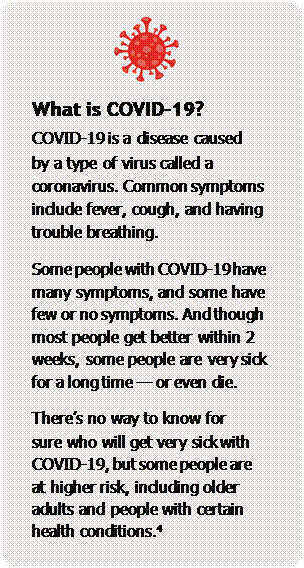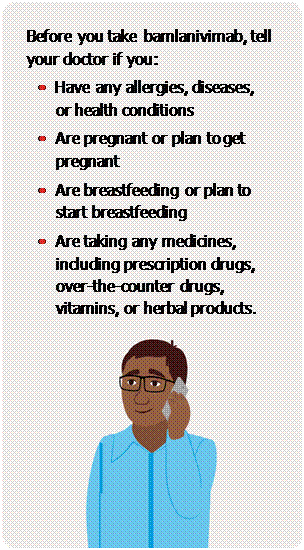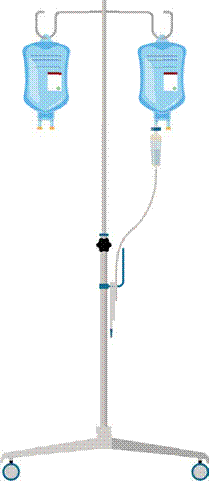
If you’ve recently been diagnosed with the COVID-19 virus, your doctor may offer you a new drug called bamlanivimab (bam-la-NIV-i-mab).
The research so far shows that for certain people, taking this drug may help limit the amount of virus in the body. This may help their symptoms improve sooner — and they may be less likely to need to go to the hospital.1 But bamlanivimab is a new drug that’s still being studied, so there’s a lot that scientists don’t know about the benefits and risks.
In this easy-to-read guide, you’ll learn about this new drug and what to expect before, during, and after treatment.
 Important facts about bamlanivimab:
Important facts about bamlanivimab:
Bamlanivimab is investigational, which means it’s still being studied. Bamlanivimab has not been approved, but has been authorized for emergency use by the United States Food and Drug
Administration (FDA), to treat mild to moderate COVID-19 in adults and pediatric patients with positive results of direct SARS-CoV-2 viral testing who are 12 years of age and older weighing at least 40 kg (about 88 pounds), and who are at high risk for progressing to severe COVID-19 and/or hospitalization.
FDA has authorized bamlanivimab for emergency use only during the COVID-19 pandemic. Bamlanivimab is authorized for the treatment of mild to moderate COVID-19 in adults and pediatric patients with positive results of direct SARS-CoV-2 viral testing who are 12 years of age and older weighing at least 40 kg (about 88 pounds), and who are at high risk for progressing to severe COVID-19 and/or hospitalization only for the duration of the declaration that circumstances exist justifying the authorization of the emergency use of bamlanivimab under Section 564(b)(1) of the Act, 21 U.S.C. § 360bbb-3(b)(1), unless the authorization is terminated or revoked sooner.
This guide is not a substitute for the official fact sheet. For information on the authorized use of bamlanivimab and mandatory requirements under the Emergency Use Authorization, please review the FDA Letter of Authorization, Fact Sheet for Healthcare Providers, and Fact Sheet for Patients,Parents and Caregivers.
 Who is this drug for?
Who is this drug for?
Bamlanivimab is a treatment option for people with COVID-19 who:2
• Are age 12 or older
• Weigh 88 pounds or more
• Have had mild to moderate symptoms for 10 days or less
• Are at high risk to get very sick from COVID-19
This drug is not for people who are already in the hospital because of their COVID-19 symptoms.
Am I at high risk?
For adults, bamlanivimab may be an option if you:
• Are age 65 or older
• Have obesity, with a body mass index (BMI) of 35 or higher
• Have diabetes, chronic kidney disease, or a condition that weakens the immune system
• Take medication that weakens the immune system
• Are age 55 or older and have heart disease, high blood pressure, or a long-term lung disease
For pediatric patients age 12-17, bamlanivimab may be an option if you:
• Haveobesity,witha BMIhigherthan85percentofpatientsyoursameageorgender9
• Have heart disease, sickle cell disease, or a long-term lung disease
• Have a developmental condition like cerebral palsy
• Regularly use medical technology, like a ventilator or feeding tube
If you’re not sure whether bamlanivimab is right for you, talk with your doctor. For more detailed information about risk, see the Fact Sheet for Healthcare Providers at bamlanivimab.com.
2 U.S. Food and Drug Administration: http://pi.lilly.com/eua/bamlanivimab-eua-fda-authorization- letter.pdf
3 U.S. Centers for Disease Control and Prevention: https://www.cdc.gov/healthyweight/bmi/calculator.html
4 U.S. Centers for Disease Control and Prevention: cdc.gov/coronavirus/2019-ncov/symptoms-testing/symptoms

 What are the side effects?
What are the side effects?
Side effects can range from mild to serious and may include:5
• Wheezing (noisy breathing that may sound like whistling) or trouble breathing
• Swollen lips, face, or throat
• Flu-like symptoms (fever, sweating, chills, cough, sore throat, headache, or muscle pain)
• Upset stomach (nausea, vomiting, or diarrhea)
• Itching, swelling, rash, or hives
• Dizziness or low blood pressure
• Changes in your heartbeat
Tell your doctor or nurse right away if you have any side effects during or after your infusion. Some of these side effects may be signs of a serious allergic reaction.
Keep in mind that only a limited number of people have taken bamlanivimab, and scientists are still learning about its side effects and risks. Serious and unexpected side effects may happen.
It’s also possible that bamlanivimab could make it harder for your body to fight off a future COVID-19 infection — and it could make a future COVID-19 vaccine less effective for you. Scientists haven’t done specific studies to address these possible risks. If you have any questions, talk with your doctor.
What if I’m pregnant or breastfeeding?
Scientists haven’t treated many pregnant or breastfeeding people with bamlanivimab. It’s possible that the drug may have more benefits than risks for them and their babies. Talk to your doctor about your options and your specific situation.
5 U.S. Food and Drug Administration: http://pi.lilly.com/eua/bamlanivimab-eua-fda-authorization-letter.pdf
How does the drug work?
When there’s a virus in your body, like COVID-19, your immune system makes antibodies to fight it off. But it takes time for your body to make antibodies for a new virus — and in the meantime, you could get very sick.
Bamlanivimab is a neutralizing antibody drug. That means it contains man-made antibodies that are similar to the antibodies of patients who recovered from COVID-19. Scientists think that these antibodies may help limit the amount of COVID-19 virus in your body. This could give your body more time to learn how to make its own antibodies.6
6 Coronavirus Prevention Network: https://coronaviruspreventionnetwork.org/coronavirus-vaccine-and-antibody-science/
7 U.S. Food and Drug Administration: http://pi.lilly.com/eua/bamlanivimab-eua-fda-authorization-letter.pdf
How will I take the drug?
 You only need to take the drug 1 time. It’s usually given at a hospital, clinic, or infusion center, and the appointment takes about 3 to 4 hours.
You only need to take the drug 1 time. It’s usually given at a hospital, clinic, or infusion center, and the appointment takes about 3 to 4 hours.
The treatment is an intravenous (IV) infusion, meaning the drug goes directly into your blood over about 1 hour. A nurse will insert a small needle into a vein in your arm to give you the drug.8
Does the infusion hurt?
With any infusion treatment, you may feel a pinch or sting when the needle first goes in, but the feeling often goes away after a few seconds.9 If you feel any pain during the infusion, tell the nurse right away.
After the infusion, some people may have pain, bleeding, bruising, soreness, or swelling in the place where the needle went in. In some cases, this may lead to more serious problems, like an infection.
If you’re not sure whether what you’re feeling after the infusion is normal, it’s always okay to call your doctor or the infusion center and check.
8 U.S. Food and Drug Administration: http://pi.lilly.com/eua/bamlanivimab-eua-fda-authorization-letter.pdf
9 American Academy of Allergy, Asthma, and Immunology: https://www.aaaai.org/conditions-and-treatments/library/immune-deficiencies-library/ivig
10 Coronavirus Prevention Network: https://coronaviruspreventionnetwork.org/coronavirus-vaccine-and-antibody-science/
How can I get ready for my appointment?
Plan for the infusion appointment to take about 3 to 4 hours. Most people are able to go home the same day, unless they have very serious side effects from the infusion.11
Before your appointment, make sure to get a good night’s sleep, drink plenty of water, and eat a light meal. Wear warm, comfortable clothes, including a shirt with sleeves you can roll up over your elbows. It’s also important to wear a mask to help prevent the spread of COVID-19.12
Ask the clinic staff if there’s anything else you need to know. They may ask patients with COVID-19 to take some extra steps to help keep the virus from spreading. You may want to ask questions like:
• What do I need to bring with me?
• When I arrive, should I call instead of coming into the waiting room?
• Will I need someone to give me a ride home after the infusion?
To help prevent the spread of COVID-19, friends and family usually can’t be with you during the infusion. If you have any concerns about this, talk with the clinic staff before your appointment.13
11 Eli Lilly and Company: http://pi.lilly.com/eua/bamlanivimab-eua-factsheet-hcp.pdf
12 National Infusion Center Association: https://infusioncenter.org/how-to-prepare-for-your-infusion/
13 National Infusion Center Association: https://infusioncenter.org/infusion_resources/covid-19/
14 National Infusion Center Association: https://infusioncenter.org/how-to-prepare-for-your-infusion/
What is it like to get the infusion?
Starting the infusion
When you get to the hospital, clinic, or infusion center, a nurse will show you to a chair where you can sit comfortably during the infusion process. The nurse will clean your arm with a special liquid that kills germs. Then they’ll insert a small needle into a vein and start the flow of medicine.
During the infusion
Once the infusion has started, it takes about 1 hour. From time to time, a nurse will come to check on you and measure your temperature, breathing, and heart rate.
When the infusion is over, you’ll need to stay for a couple of hours so the nurse can keep checking on you to make sure you’re feeling okay.
15 National Infusion Center Association: https://infusioncenter.org/infusion_resources/covid-19/
What happens after my appointment?
In the days and weeks after your infusion, your doctor or the clinic staff will keep checking with you to see how you feel and which COVID-19 symptoms you have.
They may also ask you to come in again to do another COVID-19 test or to take samples of blood from your arm.
If you have any new symptoms or side effects, tell your doctor right away. You can also report side effects to FDA MedWatch at www.fda.gov/medwatchor by calling 1-800-FDA-1088.
How soon does the treatment start working?
Everyone is different, so there’s no way to know for sure. In clinical trials, people who took bamlanivimab started to see their symptoms improve after about
6 days, on average, compared to 8 days for people who took an infusion with no medicine in it.16
Even after the treatment, you could still pass COVID-19 to other people. It’s important to stay away from other people for as long as your doctor tells you to.
16 Eli Lilly and Company: http://pi.lilly.com/eua/bamlanivimab-eua-factsheet-hcp.pdf